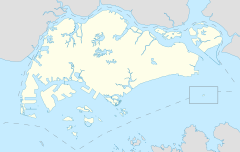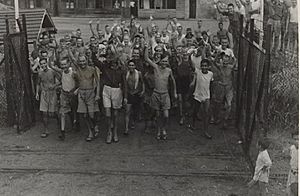Changi Prison facts for kids

The Prison Link Centre of the Changi Prison Complex in Changi, Singapore.
|
|
| Coordinates | 1°21′25.47″N 103°58′25.11″E / 1.3570750°N 103.9736417°E |
|---|---|
| Status | Operational |
| Security class | Maximum |
| Capacity | 11,000 |
| Opened | 1936 (90 years ago) |
| Managed by | Singapore Prison Service |
Changi Prison Complex, often called Changi Prison, is a large prison complex in Changi, Singapore. It is located in the eastern part of the country. This prison is the oldest and biggest in Singapore. It covers an area of about 50 hectares (about 123 acres). Changi Prison first opened in 1936 and has a very interesting history.
Changi Prison was built in 1936 by the British government. It replaced an older prison in Pearl's Hill. The British wanted a bigger prison because Singapore was growing fast. The new prison was designed to hold up to 600 prisoners.
Contents
Changi Prison During World War II
During World War II, Changi Prison became very well-known. After the Fall of Singapore, it was used as a prisoner-of-war camp by the Japanese. They held Allied soldiers captured from all over Asia. Many prisoners faced very difficult conditions. They suffered from hunger, sickness, and harsh treatment. A sad number of them died during this time.
After the War: A New Role
After World War II, the British used Changi Prison for different types of prisoners. This included people held for political reasons. In the 1950s and 1960s, the prison became a symbol of Singapore's fight for independence. Many people who worked for independence were held there.
The prison also helped Singapore grow after it became independent. Many prisoners worked in farming and construction. In the 1970s and 1980s, Changi Prison was updated. New buildings were added, including a high-security area for dangerous prisoners.
Changi Prison Today
Today, Changi Prison is still an important part of Singapore's justice system. It is known for its strict rules and focus on helping prisoners. The prison offers programs like education and job training. These programs help prisoners learn new skills. The goal is to help them live better lives after they are released. The Changi Chapel and Museum is also located near the prison.
People Held at Changi Prison
Many different people have been held at Changi Prison throughout its history. During World War II, it held many Allied soldiers. After the war, it held political prisoners and others.
Notable Prisoners of War
- Russell Braddon (1921–1995): An Australian writer who wrote "The Naked Island" about his time as a POW.
- James Clavell: A famous author who wrote the book King Rat based on his experiences there.
- John Coast (1916–1989): A British writer who wrote one of the first well-known books about Changi, The Railroad of Death.
- Lieutenant Colonel Sir Ernest Edward "Weary" Dunlop (1907–1993): An Australian surgeon known for his leadership during his time as a POW.
- Ronald Searle: A cartoonist who was held at Changi.
- Stanley Warren: An artist and art teacher. Murals he created while imprisoned are still at the prison today.
See also
- Changi Murals
- Double Tenth incident
- Selarang Barracks Incident



